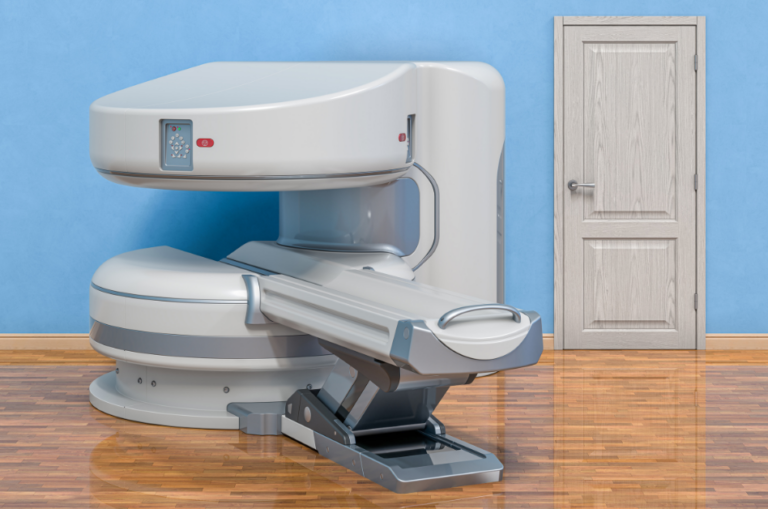My Cancer Resources is reader-supported. When you buy through links on the site, I may earn a small affiliate commission, at no cost to you. As an Amazon Associate, I earn from qualifying purchases.

Feeling anxious before having an MRI is normal. MRIs, or magnetic resonance imaging scans, are necessary to either initially stage your cancer or as a follow-up to see if treatment was successful. They don’t hurt at all, but it is common for people to dread their upcoming MRI appointment.
Most of the time, claustrophobia, or the fear of tight spaces, is the reason for the extreme anxiety. But claustrophobic patients don’t need to fear an MRI test. Here’s some MRI anxiety tips to help you prepare for your first or next scan.
What is an MRI Machine, and Why are They So Scary?
A traditional MRI machine has a long tube shape that holds large, strong magnets inside. It is housed in a small MRI exam room. After changing into a hospital gown, you’re laid down on your back on a table that will slide into the machine. After positioning you on the table, MRI technicians go into a room next door with a big window to run the MRI machine and keep an eye on you at the same time. For some, the thought of being left alone in a room for the procedure is terrifying enough, even without considering the enclosed space.
The way an MRI works is pretty cool. When the machine starts up, the strong magnetic field created by the magnets temporarily realign the water molecules in your body. Radio waves are used to create signals that then create images of the inside of the body. These images are displayed on a computer screen in the room with the technicians and then saved for the radiology team to review.
The machine can make loud knocking and buzzing noises. It’s no wonder that feeling trapped by yourself inside a machine that’s making strange noises while already being stressed about having cancer can lead to an anxiety attack!
Thankfully, with the right preparation, even the most anxious patients can have a positive MRI experience. Let’s dive into these tips that can help you remain calm during your MRI.
MRI Anxiety Tips
Learn about the safety and benefits of MRI scans
Sometimes fear of the unknown makes claustrophobia worse. Research MRI scans to learn what to expect during the procedure. MRI machines are safe and non-invasive. They use strong magnetic fields and radio waves instead of ionizing radiation, like X-rays. This means there’s no risk of exposure to harmful radiation during the procedure. Also, MRI scans don’t include injections or invasive procedures, making them pretty low-risk compared to other imaging techniques.
Knowledge is power, and being informed can help reduce anxiety associated with an MRI scan. Knowing the purpose behind the shape of the machine, and the reasons behind the noises the machine makes may help reduce MRI claustrophobia.
Talk to your doctor or MRI technician
Talk to your doctor or the technician before your MRI. They can answer questions and perhaps provide additional helpful tips beyond what is covered in this article to make your experience more comfortable.
- Voice your fears: Let your doctor know about your MRI anxiety.
- Learn about the process: Ask your healthcare provider to describe the MRI procedure – what parts of the body will be imaged and how long the procedure is expected to take.
- Look into sedation options: If you’re very anxious or have major claustrophobia, ask about mild sedation options.
Your doctor may recommend mild anti-anxiety medication to help you relax and remain still during the MRI scan. Be sure to talk about any possible side effects of these medications and if you’ll need someone to take you home after the scan if sedation medication is used.
Tour the facility before your appointment
If possible, take a tour of the imaging center before your appointment, especially if you have never had an MRI before. You may find that your facility has more modern MRI machines, like an open MRI machine, which is where magnets are just on the top and bottom, and the sides of the machine are left open.

Wide-bore MRI machines may also be available. These have wider openings giving you more space, and often the machine is built to where your head remains outside of the machine.
MRI anxiety can be dramatically reduced by being able to have your head free.
Though more rare, some facilities may have upright MRI machines, where you stand up with your head exposed during the scan.

Bring a supportive friend or family member to the appointment with you
While you can’t have anyone in the room with you during the scan, it may help to have someone who can help keep you calm and distracted and provide emotional support on the ride to the appointment and in the waiting room. Having good company can go a long way in reducing severe anxiety.
Practice positive affirmations and self-talk
Positive affirmations and self-talk can really help with MRI anxiety because they switch your focus from fear (something negative) to confidence (something positive).
You’ll use encouraging statements to lessen the fear and worries during the MRI.
- Say positive phrases: Before and during the procedure, keep repeating things like “I am relaxed and calm” and “I can manage this MRI easily“.
- Fight negative ideas: When negative thoughts come up, replace them with positive ones. For example, instead of “I can’t do this,” say “This is temporary. I have the strength to get through this“.
It’s important to find what works best for you. Some people may prefer writing down their affirmations, while others would rather repeat them in their head.
Practice these affirmations before the appointment so that during the scan you’ll be able to remember them and remain calm.
Practice relaxation techniques before the procedure
Before the MRI, you can roll your shoulders, stretch your neck and back, and practice progressive muscle relaxation. This is when you tense and release each of your muscle groups, starting with your feet and working your way up to your head.
You can do this while in the waiting room beforehand to work out some of the stress you may be holding in your body. Do it again as you’re being prepared for the scan and lying on the table, but before the MRI starts. You’ll need to remain perfectly still during the scan, or the images will not come out clearly.
Use distraction techniques during the scan
Distraction is a great way to have your mind focus on something other than being in the MRI machine. There are all sorts of ways you can distract your mind:
* Recite your favorite movie scene in your head
* solve math problems in your head
* think of a long word and figure out how many smaller words you can make by just using the letters in the long word
* anything that will keep your mind busy so you aren’t focused on the scan.
Use visualization during the procedure
Visualization is a great way to reduce anxiety at any time, no matter where you are. Simply close your eyes and imagine yourself in your happy place. This could be on a tropical beach, next to a mountain stream, or anywhere you feel relaxed and calm.
Picture the scene in great detail. Imagine yourself in the location, and include your senses to make the visualization realistic. Do you feel the sun warming your skin? Hear birds chirping? See the waves gently crashing on the shore? Visualization can transport you to a peaceful place, and before you know it, your MRI technologist will be telling you the scan is over.
Some centers have virtual reality headsets that let patients immerse themselves in peaceful settings during the scan. See if this is an option for you.
Practicing visualization before the appointment can make it easier for you to imagine yourself in another location during your scan. So start practicing a few weeks before, if you don’t already use this calming technique to reduce other stress and anxieties.
Listen to calming music or guided meditation during the procedure
If allowed, bring a set of headphones with you to your appointment. Sometimes the facility will provide them for you.
You can play calming music to help stay relaxed. You can also listen to guided meditations, which can distract you during the scan and help you focus on feeling peaceful and calm.
Noise canceling headphones can block out the loud noises of the machine so they are not a distraction to your relaxation.
If headphones aren’t allowed, ear plugs may be an option to block out noise.
Use breathing exercises before and during the MRI
Slow and steady breathing is important during an MRI. It’s important to stay as still as possible during the scan so that it can take the clearest pictures possible.
Shallow, anxious breathing makes it tough to remain still, so practice slow breaths. This will help you to move as little as possible and also has the added benefit of relaxation.
Pair breathing exercises with visualization to fight against any panic attacks.
Before the scan, you can practice box breathing to slow your breaths down. Here’s how to do it:
- Breathe in deep for a count of 4.
- Hold your breath for a count of 4.
- Exhale for a count of 4.
- Rest for a count of 4 before starting the process over again.
Consider using an eye mask during the scan
An eye mask or blindfold can help to limit what you can see during the scan. The thought behind this is that if you don’t see what you consider to be a confined space, you won’t experience claustrophobia.
Some prefer to put it on before entering the scan room, while others are fine putting the mask on before they get onto the table. Choose one that will feel soft and cooling against your skin so that you aren’t tempted to move around and try to take it off during the procedure.
A weighted sleep mask will be a bit heavier, which can help increase feelings of relaxation and calm.
See if there is a mirror you can use during the scan
If you don’t want to use a mask, you may be able to use a mirror during the scan. The staff member can position a mirror somewhere in the machine that won’t interfere with the scan.
You’re able to see outside of the machine when you look at the mirror. Sometimes seeing the bit of light from the scan room can help keep anxiety to a minimum.
Communicate with the technician during the MRI
The MRI room has a microphone and speaker system so that you can talk to the technician if needed. They’ll check in with you to see how you’re feeling and can let you know how much time is left. Most facilities provide a call button for you to use during the procedure.
If your anxiety is really ramping up and none of these techniques seem to be helping keep you calm, you can press the call button and talk to the medical staff. They may be able to pause the scan and slide you out of the machine for a few moments to help get your breathing and anxiety back under control.
Focus on the end goal
Remember the purpose of the MRI is to take precise pictures that will help your medical team make treatment decisions and provide the best medical care possible. Another type of scan may not provide the detail that’s needed to make these critical decisions.
Knowing that it’s a fairly short process, and that you can be removed from the machine within seconds in an emergency can provide some additional comfort.
Focus on the end goal of getting clear pictures to help you on your cancer journey, and that may give you the added strength to release some of those fears.
Final Thoughts
Though MRI scans can bring up anxiety and fears around claustrophobia, remember those feelings won’t last. Use the MRI anxiety tips covered in this article to reduce fear and claustrophobia, so that you can have the best MRI experience possible.



